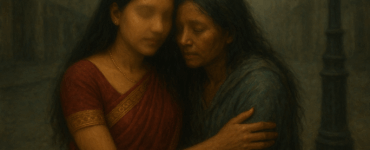Post Box No. 203, Nala Sopara is an award-winning novel in Hindi by Chitra Mudgal, originally published in 2016. The novel has been translated into English by Madhu Sriwastav and published from Sahitya Akademi in 2022. Dealing with the life of a transgender, the book is a poignant narrative of an individual’s struggle against the majoritarian society. One of the primary tasks of the translator is to expand the horizon of readership for a particular work. This facilitates literary exchanges across cultures and also, more importantly, it allows the unheard-of voices to gain strength. Post Box No 203 Nala Sopara is a significant work as it gives voice to an extremely marginalised individual who in spite of being born in a free society, does not have the freedom to live life as freely as other fellow beings. Trapped in an unconventional sexuality, the protagonist has to live a life of deprivations, humiliations and even penury. By translating such a significant work from Hindi to English, Madhu Sriwastav successfully takes this work to a larger number of readers. It is through translation in to multiple languages can the voice of the protagonist reach far and wide. Translation into English might open doors for its translation into other languages as well by inspiring a host of other translators working with different languages. Following is an interview with the translator where she speaks of her experiences in translating this novel.
This is your first full length work of translation, isn’t it? What made you choose this novel, Post Box No.203 Nala Sopara?
Yes, this is the first novel I have translated though I have engaged with translation in other literary forms. I began my translation journey by translating a couple of short stories from Bengali and Hindi into English which were published. The experience propelled me to take on more, I started translating Shakespeare’s sonnets, some more Hindi and Bengali poems and then a section of the Mahabharata and a few short stories for a Sahitya Akademi anthology.
Honestly speaking I was hungry for translation. I was on the lookout when I got to know about the Sahitya Akademi translation project from Prof Sanjukta Dasgupta. At first, I was skeptical as the commitment for a full-length novel would require time and discipline from my daily schedule which was already full. I was immediately hooked to the book as it made me cry and smile and churned me emotionally and intellectually. As a mother with a son who was close to the age of the protagonist I could feel their pain of separation. I submitted a sample for approval from Sahitya Akademi. This is how I got to translate Post Box No Nala Sopara.
The translation reads very lucid and gripping. Was there anything particular about the original narrative that made you choose this style?
The original narrative has this quality or it could not have been transmitted to the translation. It is absolutely gripping; I would compare it to a Harry Potter novel that casts a spell on the reader and it is impossible to put down the book until one reaches the end. However, there is no magic in this book, it is rather dark and disturbing but it is equally gripping because of the deep-seated emotions it stirs, the questions it asks and the psychological levels it explores. I believe lucidity is a given for a good story to be told. If the reader is bored or has difficulty reading, s/he might not reach the finish line, especially in todays’ world where one’s attention span is extremely short. So, to read a full novel the average reader must be able to glide through it. As a translator I tried to maintain that.
As a translator, one is often forced to make compromises and prioritise according to one’s ethos. While translating this work, what did you prioritise – lucidity or faithfulness?
Well, I tried to strike a balance between the two. My intention was very clear, that the reader must be able to grasp the sense that is being conveyed, the meaning and feeling should not be compromised. My aim was that meaning should find proper expression in the target language. Basic structural difference between English and Hindi has consequences on how meaning is organized in these languages, all the way to the discourse level. This was an important factor that needed to be considered while translating. So, the order of words has been altered when required but the meaning has been kept intact as far as possible.
Can you give a few examples where you had to negotiate, keeping in mind the above question?
There are instances where there are very short sentences in the original but in translation, I had to merge a few to make the meaning clear.
For e.g. Chap 1, pg. 8 when the protagonist talks about the pain in his mother’s feet; how he would press his mother’s feet to his chest and fall asleep. Here the author creates an intensity that escalates the feeling of the protagonist not only through words but also through sentence construction. I have followed this pattern in translation but in one or two places I have merged them keeping intact the pace and intensity and meaning of the text. I have used a comma instead of a full stop to merge sentences. There are many such lines where sentences have been merged and also lines comprised of a single or double words that had to be expanded to transmit the meaning.
There are quite a few instances where you have retained the original words or phrases. What made you decide to do so?
Readers of the English language should also get a flavour of the original language, it was a conscious attempt to give glimpses of the culture and language that is being translated. The novel beautifully draws the cultural milieu of a cosmopolitan Gujarati, Marathi, Hindi setting with characters from different strata of society. Indian languages have more kinship terms than English, these were retained. Moreover, everything is not translatable, retaining the original and providing the meaning in the glossary helped maintain the lucidity of the novel.
One example that I would like to cite is as follows. The place where the transgenders live with their Sardar is called ‘thikana’. I couldn’t find a suitable alternative in English for it is neither home, nor is it shelter. It’s a place they are forced to inhabit. Similarly, a) words denoting the specific food items, here from a Gujrati cuisine, have been retained in the translation eg – thepla, khandwi, shrikhand, etc b) words of abuse e.g. kalanki, karamjali, barkhordar, have been retained C) kinship terms of a Gujrati, Punjabi, Marathi, Hindi lexicon eg, Ba, pappa, dikra, mota bhai, Bhabhi, bauji, biji, etc have also been used, sometimes creatively.
As a translator, do you think English translation generalises the nuances that are present in other Indian languages and present a homogeneous representation? How did you negotiate that in your work?
No, I don’t think so. English translation no doubt is a way to enlarge the readership of a book but a good translation, rather a faithful translation will negotiate with the nuances of the language that is being translated. I have tried to retain rhetorical devices as far as possible because a translated work should have its literary appeal. Only then can it be considered as literature. The style of the author can never be fully transmitted in a translated work but it should have a literary flavour of its own.
E.g. ताप से पिघलती सुनहरी बर्फ सा चेहरा। उस चेहरे की खामोश सुबक सी फूटती श्रींण धाराओं में कल -कल, छल -छल नहीं, पकड़ से छूटते अवलम्बन की पिघलती आशंका रिस रही है
“A golden face, like ice melting with warmth! The silent sobs of the face broke not into the splosh-splash of streams, but into the oozing of the apprehensive loss of a support.”
Some lines like the following will show how I worked around the nuances of Hindi into English-
Ch -1 तुमने स्कूल के लिए निकलते समय, चुपके से मेरी जेब में सरकाए जाने वाले नोट की भांति, “खा लेना जो तेरे मन में आए, बीन्नी!” ढेर – सी दिलासा सरकाई थी मेरे जहन में।
When I was leaving for school, just as you had secretly slipped a currency note into my pocket saying, “Have something…whatever you like Binni!” you had slipped in a lot of hope into my consciousness!
Did you work in close contact with the author? How was your experience?
No, I had a few telephonic conversations with Chitra Ji regarding my work but I negotiated it in my own way. I took feedbacks from a very close circle of friends with whom I shared bits of my work and discussed my difficulties.
The initial experience of translating was that of slogging – like breaking down a clay pot and rebuilding it from the powered clay. Every editing gave shape to the pot, brought out the details. Honestly speaking, every time I go through it, I feel this could be written in a better way…that’s my creative mind at work. It was difficult at times, boring at others but I kept on. It was quite a journey and at one point I was deeply invested in the emotions of the protagonist. It is a labour of love. Hope my readers like my translation and Chitra’s Ji’s novel on such an important topic finds a wide readership.
This translation of yours has already won acclaim in the form of the Muse India Translation Award. Congratulations for that. How do you think this award is going to impact you as a translator?
As a translator the Muse India Translation Award 2023 reassured me of my worth as a translator. It’s encouraging and motivating but also comes with a lot of responsibility for my future enterprises. I am happy and hopeful that a national recognition might as well arouse the curiosity of readers and maybe more people will buy the book and give it a read. My greatest reward comes when someone reads it and says that they couldn’t put it down or were caught up in the emotions unravelled in the narrative, crying, smiling, feeling sad and above all being sensitised.
I definitely want to take up more translation projects of such deep and meaningful work as Chitra Ji’s.
*









Add comment